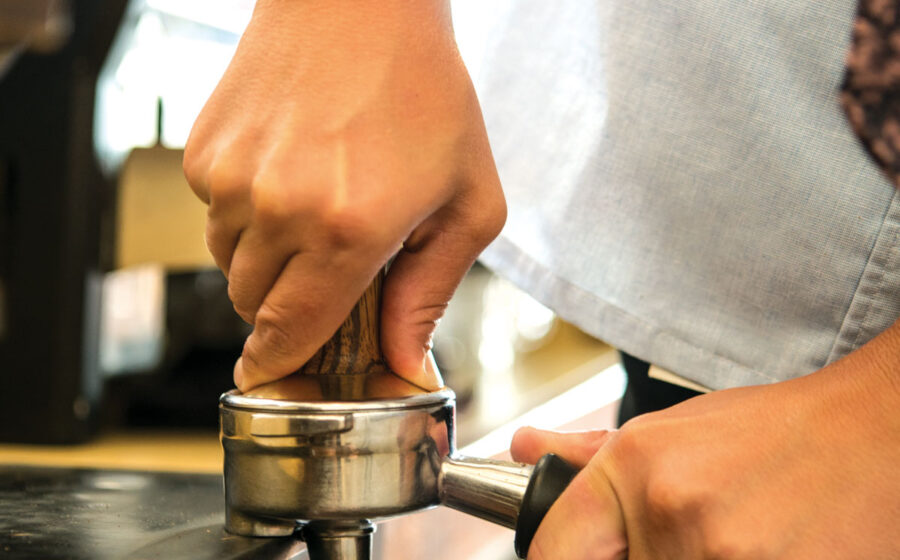[I] am never going to be able to do this effectively.”
I’m sure that I didn’t inspire much confidence in my trainer when I said that, but I was genuinely daunted by the task before me: take this chunk of metal, press it into these coffee grounds, and do it so precisely that the resulting espresso extracts evenly, beautifully, and expeditiously. Then do it the exact same way over and over.
“Here,” she said, as she pushed something across the counter in my direction, “try this.” It was an analog bathroom scale, and for the next ten minutes, I tamped on that scale until pressing with exactly thirty pounds of pressure became automatic. That was the magic number: thirty pounds. If I tamped more lightly than that, the espresso would be watery. More heavily, and you could fill a fountain pen with the ink that came out of the machine.
A whirlwind of research, anecdotal evidence, and a desire to be different has led to a sort of Wild West approach to tamping in our industry.
Since that day so many years ago, a whirlwind of research, anecdotal evidence, and a desire to be different has led to a sort of Wild West approach to tamping in our industry. We see an enormous variance in how people choose to tamp, ranging from not at all to quite a bit, thank you, and with this very specific device. Espresso machine manufacturers will tout their device’s ability to produce excellent espresso without tamping the grounds at all, while new tamper purveyors crop up regularly, declaring their tamper’s work so well that you barely need an espresso machine. Hyperbole? Sure, but only a little.
For a café owner, manager, or barista, such a glut of conflicting information could cause you to utter the old refrain, “I am never going to be able to do this effectively.” But fear not! You will be able to.
Tamping—like grinding and dosing before it—requires consistency. However you decide to go about tamping, as long as you are consistent in your execution, you will be able to produce excellent espresso. I’ll give you some general truths about the goals and pitfalls, and, based on that, tell you how I like to do it. Whatever you do, just be consistent.
Tamping the properly dosed loose grounds into a solid puck of coffee does a couple of important things: it slows the water passing through the coffee, which allows more contact time (more extraction!), and creates an uniform density throughout the bed of coffee, ensuring that the extraction is even.
I hold my tamper in my hand the same way I hold a flashlight or a doorknob. Then I twist my entire arm around so that the flat base of the tamper is parallel with the counter. This forces me to use my whole arm in the tamping motion, rather than just my wrist (which can happen if you hold your tamper like a rubber stamp). It’s much more ergonomic, and allows me to tamp with consistent pressure without putting stress on my wrist. While thirty pounds of pressure is a good standard, it’s not one that I stick to in training. The exact pressure isn’t what matters, it’s the consistency.

The actual tamping process involves a single, level press straight down into the bed of coffee. There’s no need to press it twice, give it a twist, or tap the side of the portafilter with the tamper. All of those things are just extra steps that open up more variables that might ruin the shot. This is important, because when assessing my espresso, I want to manipulate as few variables as possible to get to an excellent shot. The more things I’m changing, the longer it’s going to take me to get there.
It is possible to change how quickly your espresso shots pull by manipulating your tamping force. This is not recommended, as it is nearly impossible to reproduce with machine-like consistency. For instance, if your espresso is pulling too quickly, we know that your extraction is low, and you could be producing a watery shot with unpleasant flavors. You could just tamp the next shot a lot harder, and it would pull slower. Problem solved, right? Well, not really. How much harder did you tamp? Can you tamp with exactly that much pressure for the rest of the day?
You should adjust your grind size to address this issue. Your grinder is designed to allow minute and repeatable adjustments that will make consistent changes to your espresso. Your arm, as nice as I’m sure it is, isn’t a precision pressure applicator at all, and can’t make the kind of tiny adjustments with the same consistency that a machine can.
By tamping with consistency—as best you can, and this is a skill that develops—you can virtually eliminate tamping as a variable in your espresso-making process. A firm, level tamp that has approximately the same pressure applied each time should lead to reasonably consistent results. When something goes awry in how the shots are pulling, I can safely adjust the grind without worrying too much that it’s another factor altering my extraction.
Effective tamping, far from being scary and out of reach for most baristas, is attainable. When we remove some of the rigidity and “flair bartending” movements from the process, it finds a much more natural home in the steps of creating amazing espresso. You, like thousands of baristas around the world, will confidently be able to say, “I am absolutely going to be able to do this effectively.”
—Nathanael May is director of coffee for Portland Roasting.
















